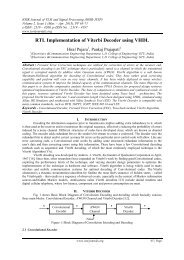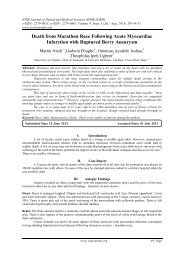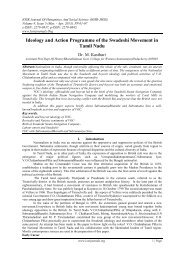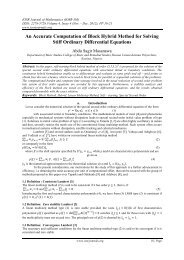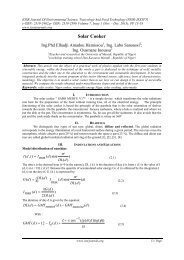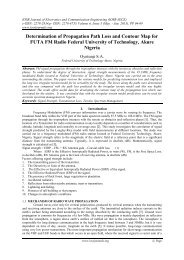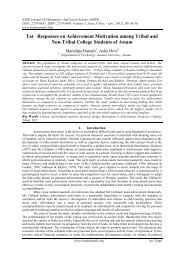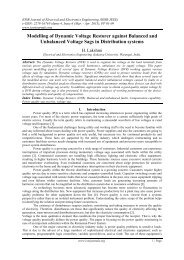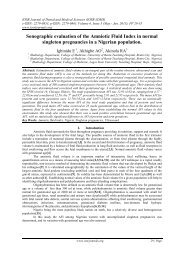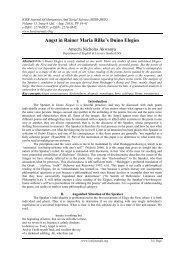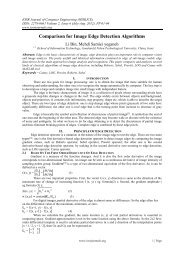Design Compatibility of Classroom Furniture in Urban and ... - IOSR
Design Compatibility of Classroom Furniture in Urban and ... - IOSR
Design Compatibility of Classroom Furniture in Urban and ... - IOSR
You also want an ePaper? Increase the reach of your titles
YUMPU automatically turns print PDFs into web optimized ePapers that Google loves.
Placards As A Language Of Civil Protest In Nigeria: A Systemic-Functional Analysis Of The Fuel<br />
the context, which consists <strong>of</strong> the field (what is go<strong>in</strong>g on), tenor (the social roles <strong>and</strong> relationships between the<br />
participants), <strong>and</strong> the mode (aspects <strong>of</strong> the channel <strong>of</strong> communication). Specifically, the ma<strong>in</strong> thrust <strong>of</strong> analysis<br />
is the channel <strong>of</strong> communication, that is, the protesters‟ placards <strong>and</strong> the implicit l<strong>in</strong>guistic messages they were<br />
meant to convey.<br />
II. Framework<br />
Systemic functional grammar (SFG) or systemic functional l<strong>in</strong>guistics (SFL) is a model <strong>of</strong> grammar<br />
developed by Michael Halliday <strong>in</strong> the 1960s, which takes a functional approach to grammar, analyz<strong>in</strong>g language<br />
as a social-semiotic <strong>of</strong> communicative mean<strong>in</strong>g-mak<strong>in</strong>g. Language <strong>and</strong> <strong>in</strong>teraction are def<strong>in</strong>ed by context <strong>and</strong><br />
this model seeks to show how contextual mean<strong>in</strong>g is expressed <strong>in</strong> grammar. SFG is „systemic‟ <strong>in</strong> that grammar<br />
consists <strong>of</strong> a series <strong>of</strong> choices that can be made <strong>in</strong> order to express ideas; <strong>in</strong> other words, language represents a<br />
system network with<strong>in</strong> which language choices are mean<strong>in</strong>gful <strong>in</strong> relation to other choices that are suppressed. It<br />
is „functional‟ <strong>in</strong> that the systems achieve certa<strong>in</strong> functions which are realized <strong>in</strong> the lexico-grammar <strong>of</strong> the<br />
language. There are three „metafunctions‟ formulated by Halliday (1994) which form the basic foundation on<br />
which Systemic Functional Grammar is based.<br />
Metafunctions are broadly-categorized fundamental functions which each concerns a different k<strong>in</strong>d <strong>of</strong><br />
mean<strong>in</strong>g with<strong>in</strong> grammatical clauses. The „experiential‟ metafunction <strong>in</strong>cludes the happen<strong>in</strong>gs, or the topic, <strong>of</strong> a<br />
text. An analysis from this perspective consists <strong>of</strong> exam<strong>in</strong><strong>in</strong>g the system <strong>of</strong> TRANSITIVITY realized as<br />
„processes‟ <strong>in</strong> a verb phrase constituent <strong>and</strong> its associated participants. There are several k<strong>in</strong>ds <strong>of</strong> processes <strong>and</strong><br />
participant types which are given different functional labels accord<strong>in</strong>g to their role <strong>in</strong> a clause. The four ma<strong>in</strong><br />
types <strong>of</strong> process are material, mental, relational <strong>and</strong> verbal, which each have assigned participants relat<strong>in</strong>g to<br />
each other by means <strong>of</strong> the process. The „<strong>in</strong>terpersonal‟ metafunction <strong>in</strong>volves the structure <strong>of</strong> clausal elements<br />
as they manage the <strong>in</strong>terpersonal relationship between speaker <strong>and</strong> addressee <strong>and</strong> achieve the communicative<br />
purpose <strong>of</strong> a text. The MOOD realizes this metafunction <strong>and</strong> elements <strong>of</strong> modality, tense <strong>and</strong> polarity are taken<br />
<strong>in</strong>to account. The „textual‟ metafunction organizes clauses as messages realized by speakers who arrange the<br />
ways <strong>in</strong> which the various groups <strong>and</strong> phrases <strong>in</strong> the clause are ordered with the THEME system.<br />
Systemic-Functional L<strong>in</strong>guistics (SFL) is a theory <strong>of</strong> language centred on the notion <strong>of</strong> language<br />
function. While SFL accounts for the syntactic structure <strong>of</strong> language, it places the function <strong>of</strong> language as<br />
central (what language does, <strong>and</strong> how it does it), <strong>in</strong> preference to more structural approaches, which place the<br />
elements <strong>of</strong> language <strong>and</strong> their comb<strong>in</strong>ations as central. SFL starts at social context, <strong>and</strong> looks at how language<br />
both acts upon, <strong>and</strong> is constra<strong>in</strong>ed by, this social context. The analysis <strong>of</strong> context is broken down <strong>in</strong>to field,<br />
tenor, <strong>and</strong> mode, which collectively constitute the „register‟ <strong>of</strong> a text (Halliday, 1985). The field refers to what is<br />
happen<strong>in</strong>g, the nature <strong>of</strong> the social <strong>in</strong>teraction tak<strong>in</strong>g place, what is it that the participants are engaged <strong>in</strong>, <strong>in</strong><br />
which language figures as an essential component. Tenor is concerned with who is tak<strong>in</strong>g part; the social roles<br />
<strong>and</strong> relationships <strong>of</strong> participant, the status <strong>and</strong> roles <strong>of</strong> the participants. The mode is the symbolic organization <strong>of</strong><br />
the text, rhetorical modes (persuasive, expository, didactic, etc); the channel <strong>of</strong> communication, such as spoken<br />
or written, monologic or dialogic, visual contact, computer-mediated communication, telephone, etc.<br />
In this paper, we adopt the „functional‟ aspect <strong>of</strong> SFL, which is concerned with the contextualised <strong>and</strong><br />
practical uses to which language is put <strong>in</strong> analys<strong>in</strong>g the l<strong>in</strong>guistic messages <strong>of</strong> the placards displayed dur<strong>in</strong>g the<br />
fuel subsidy removal protests <strong>in</strong> Nigeria.<br />
III. Data Analysis<br />
As earlier noted, the Systemic-Functional Grammar analyses language <strong>in</strong> terms <strong>of</strong> four strata, one <strong>of</strong><br />
which is the context, <strong>and</strong> one that is further broken down <strong>in</strong>to field, tenor, <strong>and</strong> mode. The thrust <strong>of</strong> analysis is<br />
the mode, which is concerned with the symbolic organization <strong>of</strong> the text, rhetorical modes, <strong>and</strong> the channel <strong>of</strong><br />
communication. In this regard, the channel <strong>of</strong> communication is placards with different <strong>in</strong>scriptions that<br />
mirrored the peculiar m<strong>in</strong>dsets <strong>of</strong> the protesters <strong>and</strong> the communicative functions, which they <strong>in</strong>tended the<br />
l<strong>in</strong>guistic messages to achieve. Generally, we have categorised a sample <strong>of</strong> the placards <strong>in</strong>to five based on their<br />
thematic unity – fuel subsidy removal, <strong>of</strong>ficial corruption, crash <strong>in</strong> public expectations, governance, <strong>and</strong><br />
revolution. We set out to exam<strong>in</strong>e how the protesters maximised the utilitarian communicative value <strong>of</strong> placards<br />
to address these different but related issues that are <strong>of</strong> grave implications for governance <strong>in</strong> Nigeria.<br />
3.1 Fuel subsidy removal<br />
A major component <strong>of</strong> the policy fiscal consolidation (2012-2015 Medium Term Fiscal Framework<br />
(MTFF) <strong>and</strong> the Fiscal Strategy Paper (FSP) is government‟s <strong>in</strong>tent to phase out fuel subsidy, beg<strong>in</strong>n<strong>in</strong>g from<br />
the 2012 fiscal year. The policy, as President Jonathan claimed <strong>in</strong> his submission to the National Assembly,<br />
“will free up to about N1.2 trillion <strong>in</strong> sav<strong>in</strong>gs, part <strong>of</strong> which can be deployed <strong>in</strong>to provid<strong>in</strong>g safety nets for poor<br />
segment <strong>of</strong> the society to ameliorate the effects <strong>of</strong> subsidy removal.” This proposed fiscal policy susta<strong>in</strong>ed by<br />
stereotypical <strong>and</strong> tasteless recitation <strong>of</strong> wonky <strong>and</strong> threadbare economic arguments <strong>of</strong> the federal government <strong>in</strong><br />
www.iosrjournals.org<br />
18 | Page



